Roe deer
![]()
The title of this article is ambiguous. For other meanings, see Deer (disambiguation).
The roe deer (Capreolus capreolus), also called European roe deer to distinguish it from the Siberian roe deer, is the most common and smallest species of deer in Europe. As a deer, it is more closely related to the reindeer, elk and the American white-tailed deer than to the red deer, which is also native to Central Europe.
The roe deer originally inhabited forest edge zones and clearings. However, it has successfully developed a number of very different habitats and now also occurs in open, almost coverless agricultural steppe. Startled roe deer usually seek shelter in thickets with a few quick jumps, it is therefore and because of some morphological characteristics attributed to the so-called "hatchling type". Roe deer are ruminants and are called selectors because they prefer to graze on protein-rich food. During the summer months, roe deer live mainly singly or in small groups consisting of a doe and her fawns; in winter, hops form, usually comprising more than three or four animals. Deer living in the open agricultural landscape form hops of more than twenty individuals.
The roe deer is subject to hunting law and is classified there as cloven-hoofed game and small game. In Germany alone, more than one million roe deer are hunted each year. Due to its behavioural characteristics, it plays no role in agricultural game management.
The roe deer has been selected as the 2019 Animal of the Year by the German Wildlife Foundation.
Features
Adult deer have a body length of 93 to 140 centimetres and reach a shoulder height of between 54 and 84 centimetres. They weigh between 11 and 34 kilograms, depending on their nutritional status. Weight tends to increase from southwest to northeast, from lower to higher elevations, and from warmer to colder climates. For example, ricken weigh an average of 17.1 kilograms in southwestern Spain and 23.2 kilograms in northern Spain. In Norway, on the other hand, doe reach an average weight of 28.8 kilograms. There is no pronounced sexual dimorphism in terms of body size. Female roe deer do not wear antlers.
On the basis of several characteristics, the roe deer is assigned to the so-called "slipper type". Unlike the red deer, which flees with a fast, persistent run when disturbed and is assigned to the runner type, the roe deer seeks cover in the thicket with a few quick jumps when disturbed. It has a slightly curved and forward sloping spine, making the croup higher than the withers. The buck's antlers are relatively small. The wedge-shaped body is adapted to silently weaving through dense vegetation. The legs are dainty and long in relation to the rump, the hind legs are strongly bent at the hock.
The head is short in relation to the body length, in profile it appears almost triangular. The ears are long-oval and pointed and correspond in length to about two-thirds of the length of the head. The iris is blackish brown with a transverse pupil. The neck is slender and longer than the head. The coat consists of guard hairs, awn hairs and woolly hairs. The awns and guard hairs form the outer hairs, underneath lie the very thin and strongly curled woolly hairs. The coat is shiny in summer on the upper side of the body and the outer sides of the body, whereby the colouring can vary individually from a dark brown-red to a pale yellow. The inside of the legs and the underbelly are lighter and more yellowish. The region around the anus, called the mirror, stands out from the rest of the coat and is usually a yellowish white color. Bucks have a small white patch on the chin and on each side of the upper lip, and a white patch is also often developed above the nose area. The ears of both sexes are brown-grey on the outside with a dark to black edge, inside the ear is light grey to white. The transition from summer to winter coat takes place in September and October. It is inconspicuous at first, because the red summer coat covers the growing grey winter coat for a long time. In contrast, the change of coat, which can be seen by an observer, takes place very quickly and is completed within a week in healthy deer. In winter the colour of the coat varies between light and dark grey. Also in winter coat the underside of the body is lighter than the upper side of the body. The change from winter to summer coat takes place in Central Europe in the period from March to April. The summer hairs are first visible on the head, then on the withers. In winter, the individual hairs are hollow, which serves to provide better insulation by trapping air.
The coat of fawns is reddish brown and initially has white spotting on the back and flanks. This white spotted pattern gradually becomes less distinct from the age of one month and disappears by the age of two months due to overgrowth by red summer hairs. Under the long red hairs the white and brown fawn hairs are still present until the change into the winter coat.
Color anomalies
Besides reddish-brown roe deer, albinotic or partially albinotic individuals rarely occur. In pure albinos, the hair is completely white and the eyes are red. In the somewhat more common partial albinos, the so-called pied deer, white patches appear on various parts of the body, and the white patches can vary in size. If the deer lacks certain colour pigments, the hair can also be yellowish or silvery.
In the lowlands of northern central Germany there is a large number of black roe deer, which occur sporadically in other regions. In northern Central Germany black roe deer were probably already present around 990 in the area of Haste. Their occurrence is reliably proven for today's district of Lüchow-Dannenberg for 1591, as a letter from Landgrave Wilhelm of Hesse-Kassel to Duke Heinrich Julius of Brunswick-Wolfenbüttel has been preserved from that year, in which he asks for the promised black roe deer to be sent to him.
The colouration is explained by a strong increase of the black pigment, which suppresses the red colouration. This characteristic is probably inherited recessively. In summer, the head up to the eye line, the neck, the back and the upper part of the legs are shiny deep black. The underside of the body appears greyish black. In winter the black is somewhat duller. Fawns are also already black in color, but like normally colored fawns, they have one to two rows of light spots on either side of the spine. Black deer always make up only a small percentage of the total doe population. Even in places where the targeted shooting of red-brown roe deer was intended to increase the proportion of black roe deer, it was not possible to increase their proportion above 75 percent.
Antlers
Only the bucks carry antlers. In the hunter's language the antlers of the roe deer are also called Gehörn, in the South German-Austrian language area also as Krickl. It consists of two round to oval poles, which reach an average length of 15 to 20 centimeters with bucks in Central Europe. Normally, each rod of a normally developed, older buck has three ends: A so-called front rung as well as the actual end of the rod, also called the middle rung, and a rear rung lying in height between the two. The most important biological function of these antlers is to fight out and defend the hierarchy. The cob ends, which are equipped with scent glands, also produce a secretion until the basal skin is swept, and this secretion is wiped off on the vegetation. Since antlers are a surplus production of the body, external factors such as nutrition play a role in their development in addition to the age of the bucks. Antler development can only reach its peak after the buck's physical development is complete. As a rule, antler mass and volume reach their maximum at five-year-old bucks. Antlers can then weigh up to 600 grams. There is no evidence that bucks with stronger antlers are preferred by does.
Already three-month-old buck fawns develop projections called rosebuds on their forehead bones with the beginning of the production of the male sex hormone testosterone. These forehead cones have reached a length of 30 millimetres and a diameter of up to 10 millimetres in September/October without nutritional deficiencies of the fawns. They are still surrounded by skin, not bast. This skin is shed in the period December to January, exposing the tips of these firstling antlers. Shortly thereafter, the shedding occurs and the formation of the subsequent antlers begins. The antlers of one-year-old bucks are normally formed as a simple, unbranched spike. Rarely, the typical poles of two- and perennial bucks with two and three shoots, respectively, are already present in one-year-old bucks. Bucks that are older than five years are increasingly no longer able to completely deliver the building materials necessary for the antler structure, since they consume more minerals than they take in. The increasingly poor nutrition due to the wear of the teeth as well as possibly also a decreasing functional capacity of the endocrine gland system play a role in this.
In bucks that have completed at least the first year of life, the antlers fall off annually in the period from October to November and immediately begin to grow again under a protective and nourishing bast skin. The antler growth period lasts about 60 days and ends in January. Bucks kept in gates have been found to grow antlers at a rate of about three millimeters per day. The energy-consuming pushing of antlers in the relatively poor winter period is very rare in deer and only occurs in the Siberian roe deer and the East Asian David's deer.
The basal skin dies after completion of antler formation and is removed from the remaining bone mass by the buck by sweeping on bushes and young trees. Bucks that are at least two years old sweep their antlers in Central Europe during the second half of March and thus before they change into summer plumage. One-year-old bucks, on the other hand, sweep their antlers seven to eight weeks later, when they are already in summer plumage. Freshly swept antlers are white or slightly reddened from adhering blood. Sweeping on trees and shrubs causes bark and plant sap to penetrate the pores of the poles, giving the antlers their color. Bucks that sweep their antlers on alders and conifers tend to have very dark antlers, while the so-called field deer, which have few trees to sweep due to their habitat, typically have light gray poles. The sweeping of antlers is detrimental to trees: bucks prefer to use solitary stems and marginal plants for this purpose; the willingness of individual bucks to sweep varies. Individual bucks sweep only on a few stems, while others in crops do massive damage to hundreds of plants. Sweeping damage is hardly avoidable; the only solution is to fence off afforested crops or to protect trees individually, for example by covering the trunks with wire mesh. Compared to the browsing damage that deer can cause in forests, however, sweeping damage is minor.
Senses
The roe deer is a distinctly olfactory animal. It belongs to the so-called macrosmatics, since a high proportion of the nasal mucosa is covered with an olfactory epithelium (olfactory mucosa). About 320 million olfactory cells are located on the approximately 90 square centimetres of olfactory epithelium. Deer are able to perceive even small scent stimuli and can smell a human from a distance of 300 to 400 metres.
The sideways standing eyes allow the deer to survey a wide radius without turning its head. Deer react particularly to movements, the recognition ability for motionless objects is not very highly developed. This is probably also the reason why deer conspicuously raise and lower their heads when facing a stationary object. (When disturbed, deer straighten their heads and stare at the cause of the disturbance, often standing sideways. This characteristic behavior is called belaying). They also occasionally move slowly, neck stretched wide, in a goose step toward the suspicious apparition, stomping the ground from time to time. The behavior appears extremely curious to humans, but it is a behavior in which the deer seeks clarity about the cause of its alarm. It may immediately precede a flight.
There is no uniform assessment of the performance of the sense of hearing, as deer react very differently to different sounds. Deer can get used to loud noises and are not disturbed, for example, by the noise of a motorway or a shooting range while grazing. On the other hand, the soft cracking of a dry twig can cause them to back up and flee.
vocalizations
A barking sound is the most noticeable and commonly heard vocalization of the deer, it is referred to as a "startle sound" in technical literature, and "fright" in hunter lingo. Barking sounds are usually heard when deer are startled but have not yet identified the cause of the disturbance. The sound expresses agitation and aggression rather than fear. Among other things, a barking deer signals to the disturber that it has detected him - in this case, for a potential predator, further approach is pointless. By barking, the deer also informs its conspecifics where it is. In some regions, barking deer can be heard for about half an hour in the mornings and evenings in summer. On the other hand, fawns and doe lure each other with barking sounds. Also during the Brunft, the doe calls fiepend after the buck. For the buck, on the other hand, a wheezing, whistling snort can often be heard when driving the doe or driving away another buck.
Locomotion
The roe deer has three different gaits. In the walk it sets up the runs left behind, left in front, right behind and right in front. It steps with the hind leg approximately in the footprint of the front leg on the same side of the body. The stride length measures between 35 and 45 centimetres. The so-called troll or trot is a somewhat faster gait in which two diagonal legs - for example, left front and right hind leg - are placed on the ground at the same time. Deer show this gait relatively rarely and only over short distances.
The fastest gait of the deer is the gallop, it consists of single jumps, in which both front legs and both hind legs are placed on the ground almost simultaneously. The deer pushes itself off the ground with the help of the back muscles when stretching the hind legs, then moves through the air with a straight back without touching the ground and catches itself again with the front legs. With a strongly curved back, the hind legs are then reattached even before the footsteps of the front legs, the average jumping distance being about four meters. Deer are not able to maintain this fast gait for long periods of time, as their heart and lung capacity is not sufficient for this. Deer are good swimmers and are able to cross waters several kilometres wide.
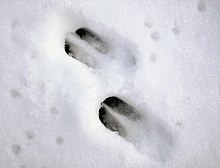
Deer track in the snow
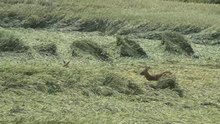
Play media file Two deer galloping in a field

horns with basal skin
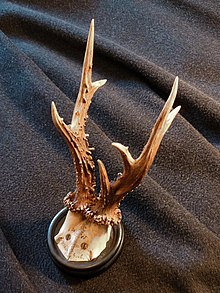
Fully developed horns of an older roebuck

Fleeing roebuck
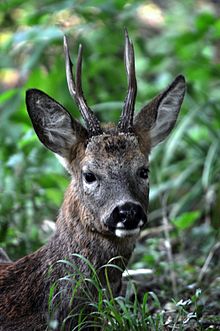
Roebuck
Distribution and habitat
Distribution area
The European roe deer occurs in almost all of Europe and in parts of Asia Minor. In the Iberian Peninsula, the range is patchy and mainly limited to mountainous areas due to climatic conditions. Deer are found in the Pyrenees, the Cantabrian and Iberian Mountains, the Montes de Toledo and in the province of Cádiz as well as in the region around Málaga. The latter is one of the southernmost ranges of the roe deer. The southern limit of its distribution continues over the southern tip of Italy, and the roe deer does not occur in Sicily and the other western Mediterranean islands. In the Peloponnese, the roe deer was eradicated at the beginning of the 20th century, but it is still common on Mount Olympus, Chalkidiki and some Greek islands. Its range also includes northern Syria, northern Iraq, Israel as far as the Sea of Galilee and Haifa, and Iran. The eastern border runs through Bulgaria and Romania, where roe deer are found throughout the country, in a northerly direction through Kropywnyzkyj, Dnipro, Borissoglebsk, Voronezh, Orjol, the west of Moscow, the Volga reservoir, the Rybinsk reservoir, the western shore of Lake Ladoga along the eastern border of Finland. In Scandinavia, the northern limit of distribution is on the Atlantic coast at about latitude 65°, and from the Baltic areas of Sweden the range extends in a narrow strip east of the Scandinavian Mountains to the Arctic Circle. There are no roe deer in Ireland, but the roe deer is widespread in Scotland and parts of England. Outside its natural range, the deer has only been naturalized in Texas. There, a range expansion has not yet taken place.
Habitat
In the forest landscape of Europe, the roe deer colonized forest clearings, forest edge zones as well as other habitats rich in undergrowth and with few trees, such as alluvial plains, deltas and reeds that do not merge into forest landscapes. Forested areas now interspersed or surrounded by agricultural land provide significantly more habitat for deer. The population density here is 10 to 20 times higher than in forested areas where the tree population has a natural age structure. Optimal roe deer habitats consist of a close-meshed mosaic of forestry and agricultural areas and feature thickets, old-growth woods, meadows, as well as aisles and roadsides overgrown with shrubs and herbs.
The altitudinal distribution ranges from the lowlands to alpine altitudes of 3,000 metres. However, it is rare in high alpine regions above the tree line and in open grassland. Regions with harsh winters and high, long-lasting snow conditions are not very suitable for deer, as they have difficulty moving and reaching food in high snow. Deer overwinter in such regions in sometimes relatively small areas where topographical features mean that less snow accumulates. Deer are also successful cultural successors that also colonize habitats that have been heavily overformed by humans. Due to their relatively small size, even small forest remnants or hedges are sufficient cover for them. Accordingly, roe deer also colonize the open agricultural steppe. A distinction is made between the forest deer and the field deer ecotypes. While the wood roe deer still inhabits habitats close to forests, the field roe deer is at home in the open agricultural landscape with little cover and has changed its diet mainly to field crops. However, field deer return to the forest edge zone, which is optimal for them, and change their diet and behaviour when the deer population density in these zones decreases.
In regions with high fallow deer, sika deer or red deer populations, roe deer tend to be rarer. There are no exact studies on the interspecific behaviour of roe deer to other animal species, but roe deer leave the grazing areas when fallow deer approach. Deer keep even more distance to red deer, also here the rutting behaviour of red deer seems to disturb deer too much. In several regions, an increase in roe deer populations has been demonstrated when red deer populations have declined. Sika deer also displace roe deer. Towards wild boars, the behaviour of roe deer varies. In places where wild boar are common and also leave their roosts during the day, both species occasionally forage on the same areas. In contrast, roe deer react to wild boars with a securing behaviour at dusk and in the dark.
colonization of new habitats
In principle, deer strive to remain in the habitat in which they were born. However, above a certain population density this is no longer possible. The decisive factor is the biotically sustainable deer density, i.e. the population density at which the body, antler and weight development of deer corresponds to the genetic and environmental possibilities. It is usually well below the grazing capacity of an area. If the biotically sustainable deer density is exceeded, deer react with weight loss and reduction of their disease resistance due to the associated stress, and an expansion of the population into previously deer-free areas begins. Where new habitat is no longer available, fawn mortality increases, fertilization rates decrease and fawn sex ratios shift in favour of males.
The colonization of new regions by roe deer has been observed and described in more detail in the course of the 20th century, among others, in the Karst region around Trieste, on newly created polders in the Netherlands, the island of Fehmarn as well as large agricultural areas in the Hungarian Tisza region. First of all, constitutionally strong one- to two-year-old bucks open up a new habitat, because they migrate further than females of the same age do. In the new, low-competition area, these bucks can become very strong conditionally. When they expand their range in winter in search of grazing, they also encounter other doe jumps in the outskirts of the established population. From these jumps, one-year-old does follow them at the end of winter. Three to five years after the initial settlement, the roe deer population increases strongly in the newly settled area, because the young females, which are in good condition due to the grazing offer, raise many young animals. The conditionally strong young bucks born here also migrate to the regions that are less densely populated or not yet populated. Migrations of more than twenty kilometres are the exception, on average the deer do not migrate further than about two kilometres.
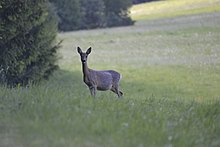
Watching deer at the edge of the forest

Deer in the rye field

Range of the European roe deer
Search within the encyclopedia